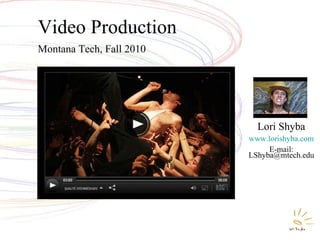
Video Production overview
- 1. Video Production Montana Tech, Fall 2010 Lori Shyba www.lorishyba.com E-mail: LShyba@mtech.edu
- 2. What is this course about? The Montana Tech Catalog capsule summary of this course says: “ Introduces the principles and practices of digital video production … scriptwriting, videography, editing, and delivery.“
- 3. Styles and Types (Modes) of Films REALISM CLASSICISM FORMALISM Documentary F I C T I O N Experimental Manufactured Landscapes Boogie Doodle Bowling for Columbine DieHard Fellini’s 8 1/2 NB. These are not airtight categories and often overlap. styles Types (modes)
- 7. What About Genre? Developed by French directors François Truffault, Jean-Luc Godard and their Cahiers du cinema associates in the mid-50s. Simultaneously with Auteur Theory, they also developed the theory of film genre. Believed that the genius of American cinema was its repository of ready-made forms saying “The tradition of genres in a base of operations for creative freedom.” Definition: A recognizable type of movie, characterized by certain pre-established conventions. Common genres are Westerns, Drama (Romance, War, Action etc.), Thrillers, Sci-Fi, Comedy, etc. A ready-made narrative form.
- 8. What About Genre? Definition: A recognizable type of movie, characterized by certain pre-established conventions. Common genres are Westerns, Drama (Romance, War, Action etc.), Thrillers, Sci-Fi, Comedy, etc. A ready-made narrative form. Genre was developed by French directors François Truffault, Jean-Luc Godard and their Cahiers du cinema associates in the mid-50s. Simultaneously with their Auteur Theory, they also developed the theory of film genre. Believed that the genius of American cinema was its repository of ready-made forms saying “The tradition of genres in a base of operations for creative freedom.”
- 10. THE PRODUCER The producer is the lynchpin between the administrative and the artistic teams. She or he finds ideas for movies and sets up the financier (studio). Producers makes sure things are on time and on budget — project management in short. They liaise between the set and the studio. The producer may handle the press, the promotions, and may contribute to final creative and casting decisions (usually because of money). Job Descriptions
- 11. THE SCREENWRITER Film scripts differ from plays because they are only blueprints of the finished product unlike a theatrical “play” that one can read with pleasure. Therefore, film scripts are rarely autonomous literary products. This speaks to the “theory of organic form” and the observation that films communicate through visual elements of interdependent form and content moving through time and space but we still need a good STORY. For better or worse, the STORY comes primarily from the pen of the screenwriter. Job Descriptions — Film Structure
- 12. FIGURATIVE TECHNIQUES Explores the use of artistic devices that suggest abstract ideas through comparison. (All are “symbolic”) Motifs can be a technique, an object, or anything that is repeated but does not call attention to itself. Eg? Symbols can be things that imply additional meaning to the sensitive observer. Eg.? In 8 1/2? Metaphor is comparison that is not literally true. Eg? 8 1/2? Cinematic metaphors can be created through montage and editing. Other figurative techniques are allegory, allusions (analogy) and homage.
- 13. POINT OF VIEW -- NARRATION First-person narrative is where the cinematic equivalent to the “voice” of a literary narrative is the “eye” or lens of the camera. Eg? Omniscient point of view is where the lens is the all-knowing observer that supplies evaluations of the scene. Eg? Voice-over narration is common and when there is a narrator that literally talks over the action. Eg? Camera as buddy is uncommon but is when the camera is treated like an active listener in the story. Eg? Another WAY TO express ORIGINAL INSIGHTS.
- 14. NARRATIVE Aristotelian Poetics distinguished between two types of fictional narratives - mimesis (showing) and diegesis (telling). Cinema combines both. Narratology is the study of of how stories work — the study of different narrative structures, storytelling strategies, types of stories (genres) and their symbolic implications. We will be looking at Realistic Narrative, Formalistic Narrative, and Classical Narrative.
- 15. DOCUMENTARY NARRATIVE Realists prefer loose, discursive plots and we are not presented with a clear-cut conflict as in classical narratives. The pretence that a realistic narrative is unmanipulated is an aesthetic deception. Often we cannot guess the principle of narrative coherence until the end of the movie. Scenes are arranged in apparently random order and everyday events are presented matter-of-factly with no “heightening” for dramatic effect.
- 16. FORMALIST NARRATIVES Formalists revel in their artificiality. The design of the plot is not concealed but heightened. It’s virtually impossible to ignore the personality of the auteur director in the film. Often interrupted by lyrical interludes like musical numbers or dreamscapes. Often uses multiple lines of narrative and juxtaposes snippets of lives, dreams, memories, and abstract formulations.
- 17. CLASSICAL NARRATIVES Derived from live theatre (Aristotelian Poetics and the “well-made-play”) the classical narrative model is based on a conflict between a protagonist, who initiates the action, and an antagonist who resists it. Most films in this form begin with an implied dramatic question -- we want to know if the protagonist will get what they want in the face of opposition. The scenes that follow escalate in an Aristotelian cause and effect with each scene linking to the next.
- 18. CLASSICAL NARRATIVES CONT. Classical paradigm emphasizes dramatic unity, plausible motivation, and coherence. Classical structures often feature double plot lines and characters who are goal oriented. Classical plot structures are linear and often take the form of a journey, a chase, or a search.
Editor's Notes
- Lesson Plan, September 8, 2007 1:00 B: Who are you? Objectives: Course Outline and Assignments, Resources -- Textbook, Facebook, Website. 1:30 Powerpoints. 2:00 - 2:20 Break 2:20 - 4:40 Film screening. 4:40 - 4:45 Writings.
